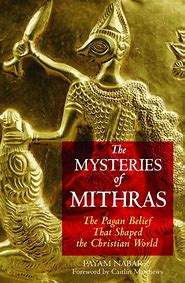We must find our way through an altered political and religious geography. The narrator, Ro Esbernsson, is a Marklander from New Denmark but Markland is no European country because the red-domed Mithraeum and blue-domed Shrine of the Good Mother in the city of Mirzabad are said to be:
"...taller than any in Europe or Markland..." (p. 76) (my emphasis)
(Mithraeum and Shrine must correspond roughly to church and Lady Chapel.)
From his boyhood, Ro remembers Ivarsthorp near the Connecticut River, also Lake Winnepesaukee and Merrimack Haven, this last sounding from its description like an Atlantic harbour. Apparently, it was the Trekfolk who came and cultivated Markland. North Markland is said to be:
"'Across the Western Sea...'" (p. 79)
Mithraists have their divisions. The Ispanyans:
"...look on our Northern godword as heretical. Asiatic Mithraists are at odds with both, but hold that different roads may lead to the same truth. In this, if in naught else, the East is wiser than the West." (pp. 75-76)
If, within our received traditions, we are free to practice as seems best to us without harassment or worse by "heresy" police, then we are more likely to find our way to some measure of truth. At least, there are fewer impediments. The East is indeed wiser.
However:
"Even the orthodox Zarathustrans have always looked on Mithraists as fallen halfway back into heathenism, the more so after our cult linked itself to that of the Good Mother. To the Puritans, we are worse than that, worse than infidels, the very creatures of Angra Mainyu." (p. 79)
We meet again "...lion-headed Aeon..." (p. 76) (Scroll down.) Accusations of heresy must dwindle to insignificance before Aeon.

7 comments:
Kaor, Paul!
Well, Mithraism in our world began as a heretical derivative of Zoroastrianism in the Hellenistic era after the conquests of Alexander the Great. Something similar happened in this alternate world.
Not sure you are right about that Mithraeum and Shrine. They seem to be different, separate structures. The Lady Chapel in Catholic churches and cathedrals are smaller parts of the SAME structures.
Ad astra! Sean
Kaor, Paul!
I forgot to mention that I appreciated Anderson's mentions of such New England features as the Connecticut River, Lake Winnepesaukee, and the Merrimack River. And that "Merrimack Haven" seems to occupy the site used by Newburyport, at the mouth of the river.
I don't often see New England locations in Anderson's stories!
Ad astra! Sean
Sean,
Sure, a Lady Chapel is part of a church. In our history, Christianity incorporated a Mother of God whereas the Mysteries of Mithras and the Goddess remained distinct. In this fictional timeline, Christianity did not exist whereas Mithraism and Goddess-worship linked to the extent of building their temples side by side.
Paul.
Kaor, Paul!
It is not quite correct to say Christianity "incorporated" a Mother of God. Catholics and Orthodox believe God asked the BVM to become the mother of his Son, the second Person of the Trinity. She became the Mother of God after the Incarnation because St. Mary gave to her Son all that any human mother gives to her children thru conception (a human body) and pregnancy. The Blessed Virgin is uniquely and highly favored, but not a goddess.
I agree with the rest of your comment, a morphing together of two different religions. I can see why that disgusted orthodox Zoroastrians, because Mithraists were relapsing into heathenism.
Ad astra! Sean
Sean,
Christian theology is a monotheist system which incorporates a "Mother of God" figure that had to be imported into the Biblical tradition. Mary was proclaimed "Mother of God" in Ephesus where Paul had denounced Goddess idolatry.
God asking Mary is not a historical event. In Luke 1, an angel informs Mary and this is obviously an invented "origin story," recounted nowhere else. Luke has Mary and Joseph taking the child to the Temple whereas Matthew has them fleeing to Egypt. Matthew wrote that story to fulfil a verse about God calling his son out of Egypt but the verse had referred to God calling his collective son, the people of Israel, out of Egypt.
Paul.
Kaor, Paul!
I disagree. The Blessed Virgin became the Mother of God because she assented to the Incarnation. Of course Christianity has origins, a BEGINNING. And I see no contradiction about Mary giving her Fiat to the Angel and St. Joseph later taking the Virgin and Child to Egypt for a time. The well known cruelty and caprice of Herod the Great makes that very plausible.
In short, I accept that the Supernatural, God, sometimes acts in this world, which you don't believe happens. Again, we disagree.
Ad astra! Sean
Sean,
When did she assent?
She was the mother of Jesus' human nature but hardly the Mother of God as such. What was the difference in popular consciousness between the phrases, "Mother Goddess" and "Mother of God"?
Luke's account assumes that Jesus was born and named, then presented in the Temple. Luke writes without any knowledge of a flight to Egypt.
Does the belief that God acts in the world precede evidence?
Paul.
Post a Comment